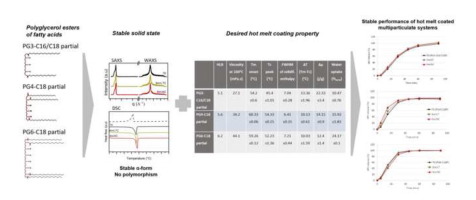当前位置:
X-MOL 学术
›
Eur. J. Pharm. Biopharm.
›
论文详情
Our official English website, www.x-mol.net, welcomes your feedback! (Note: you will need to create a separate account there.)
Novel approach for overcoming the stability challenges of lipid-based excipients. Part 2: Application of polyglycerol esters of fatty acids as hot melt coating excipients.
European Journal of Pharmaceutics and Biopharmaceutics ( IF 4.9 ) Pub Date : 2020-01-23 , DOI: 10.1016/j.ejpb.2020.01.009 Sharareh Salar-Behzadi 1 , Carolina Corzo 1 , Diogo Gomes Lopes 2 , Claudia Meindl 3 , Dirk Lochmann 4 , Sebastian Reyer 4
European Journal of Pharmaceutics and Biopharmaceutics ( IF 4.9 ) Pub Date : 2020-01-23 , DOI: 10.1016/j.ejpb.2020.01.009 Sharareh Salar-Behzadi 1 , Carolina Corzo 1 , Diogo Gomes Lopes 2 , Claudia Meindl 3 , Dirk Lochmann 4 , Sebastian Reyer 4
Affiliation

|
The application of hot melt coating (HMC) as an economic and solvent-free technology is restricted in pharmaceutical development, due to the instable solid-state of HMC excipients resulting in drug release instability. We have previously introduced polyglycerol esters of fatty acids (PGFAs) with stable solid-state (Part 1). In this work we showed a novel application of PGFAs as HMC excipients with stable performance. Three PGFA compounds with a HLB range of 5.1-6.2 were selected for developing immediate-release formulations. The HMC properties were investigated. The viscosity of molten lipids at 100 °C was suitable for atomizing. The DSC data showed the absence of low solidification fractions, thus reduced risk of agglomeration during the coating process. The driving force for crystallization of selected compounds was lower and the heat flow exotherms were broader compared to conventional HMC formulations, indicating a lower energy barrier for nucleation and lower crystallization rate. Lower spray rates and a process temperature close to solidification temperature were desired to provide homogeneous coating. DSC and X-ray diffraction data revealed stable solid state during 6 months storage at 40 °C. API release was directly proportional to HLB and indirectly proportional to crystalline network density and was stable during investigated 3 months. Cytotoxicity was assessed by dehydrogenase activity and no in vitro cytotoxic effect was observed.
中文翻译:

克服基于脂质的赋形剂稳定性挑战的新方法。第2部分:脂肪酸的聚甘油酯作为热熔涂料赋形剂的应用。
由于HMC赋形剂的固态不稳定导致药物释放不稳定,因此热熔涂层(HMC)作为一种经济且无溶剂的技术的应用在药物开发中受到限制。我们之前已经介绍了具有稳定固态的脂肪酸聚甘油酸酯(PGFA)(第1部分)。在这项工作中,我们展示了PGFA作为具有稳定性能的HMC赋形剂的新应用。选择了HLB范围为5.1-6.2的三种PGFA化合物来开发速释制剂。研究了HMC特性。熔融脂质在100°C的粘度适合雾化。DSC数据显示不存在低的固化分数,因此降低了涂覆过程中的团聚风险。与传统的HMC配方相比,所选化合物结晶的驱动力更低,热流放热量更广,这表明成核的能垒更低,结晶速率更低。需要较低的喷雾速率和接近凝固温度的工艺温度以提供均匀的涂层。DSC和X射线衍射数据显示在40°C下储存6个月期间稳定的固态。API释放与HLB成正比,与晶体网络密度成正比,在研究的3个月中稳定。通过脱氢酶活性评估细胞毒性,未观察到体外细胞毒性作用。需要较低的喷雾速率和接近凝固温度的工艺温度以提供均匀的涂层。DSC和X射线衍射数据显示在40°C下储存6个月期间稳定的固态。API释放与HLB成正比,与晶体网络密度成正比,在研究的3个月中稳定。通过脱氢酶活性评估细胞毒性,未观察到体外细胞毒性作用。需要较低的喷雾速率和接近凝固温度的工艺温度以提供均匀的涂层。DSC和X射线衍射数据显示在40°C下储存6个月期间稳定的固态。API释放与HLB成正比,与晶体网络密度成正比,在研究的3个月中稳定。通过脱氢酶活性评估细胞毒性,未观察到体外细胞毒性作用。
更新日期:2020-01-23
中文翻译:

克服基于脂质的赋形剂稳定性挑战的新方法。第2部分:脂肪酸的聚甘油酯作为热熔涂料赋形剂的应用。
由于HMC赋形剂的固态不稳定导致药物释放不稳定,因此热熔涂层(HMC)作为一种经济且无溶剂的技术的应用在药物开发中受到限制。我们之前已经介绍了具有稳定固态的脂肪酸聚甘油酸酯(PGFA)(第1部分)。在这项工作中,我们展示了PGFA作为具有稳定性能的HMC赋形剂的新应用。选择了HLB范围为5.1-6.2的三种PGFA化合物来开发速释制剂。研究了HMC特性。熔融脂质在100°C的粘度适合雾化。DSC数据显示不存在低的固化分数,因此降低了涂覆过程中的团聚风险。与传统的HMC配方相比,所选化合物结晶的驱动力更低,热流放热量更广,这表明成核的能垒更低,结晶速率更低。需要较低的喷雾速率和接近凝固温度的工艺温度以提供均匀的涂层。DSC和X射线衍射数据显示在40°C下储存6个月期间稳定的固态。API释放与HLB成正比,与晶体网络密度成正比,在研究的3个月中稳定。通过脱氢酶活性评估细胞毒性,未观察到体外细胞毒性作用。需要较低的喷雾速率和接近凝固温度的工艺温度以提供均匀的涂层。DSC和X射线衍射数据显示在40°C下储存6个月期间稳定的固态。API释放与HLB成正比,与晶体网络密度成正比,在研究的3个月中稳定。通过脱氢酶活性评估细胞毒性,未观察到体外细胞毒性作用。需要较低的喷雾速率和接近凝固温度的工艺温度以提供均匀的涂层。DSC和X射线衍射数据显示在40°C下储存6个月期间稳定的固态。API释放与HLB成正比,与晶体网络密度成正比,在研究的3个月中稳定。通过脱氢酶活性评估细胞毒性,未观察到体外细胞毒性作用。

























 京公网安备 11010802027423号
京公网安备 11010802027423号